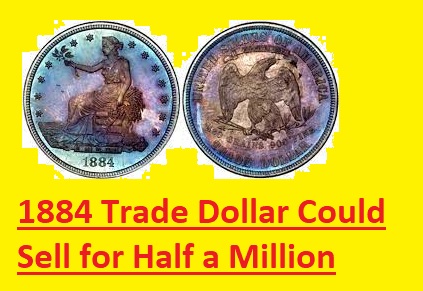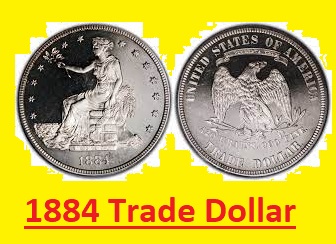Hi friends welcome to the new post. Here we will learn 1884 Trade Dollar | 1 Trade Dollar, Pattern, United States. The 1884 Trade Dollar is important in the field of coins. In the USA’s history, different coins have historical importance and attract coin collectors. In this post, we discuss different features history, and related factors of the 1884 Trade Dollar. So let’s get started with the 1884 Trade Dollar
Birth of the Trade Dollar
Early Trade Relations
At mint of the 19th century was considered as the high-speed of trade growing era of USA history. AS American businessmen entered the Asia market there is a need for coins that can be traded at the international level. To fulfill this need trade dollar was made
Pattern Coins
Patern coins were created as prototypes for design testing and getting public options before making the 1884 Trade Dollar. These patterns are used by collectors
Design
Obverse
At the front side of the 1884 Trade Dollar, there is Lady Liberty in a serene and regal fashion. Her good look shows freedom and commerce.
Reverse
At the back, there is a majestic eagle with outstretched wings clutching an olive branch and arrows, showing peace and strength.
Rarity and Value
Mintage Figures
At that time limited numbers of 1884 Trade Dollars were made. Just some made with having a good look
Current Market Value
Currently, the 1884 Trade Dollar is important for collectors Its rarity and importance make it highly sought-after in the coins field
How to trade dollar
The dollar is the number of traded currencies in the universe and there are different methods for dollar trading some are explained here
- Forex trading: it is a common method for dollar trade. In this technique, anyone can buy and sell currencies. Like we can buy EUR/ USD which means we buying euros and selling dollars.
- Futures trading: it is a derivative that helps to buy or sell a currency at a good rate in the future. Futures contracts can be traded in dollars which means dollars buy and sell at differnt rates and values on differnt dates
- CFD trading: CFD full-form contracts for difference used for dollar trading. it helps us to discuss the dollar cost without having it
- Options trading: It offers the right to buy or sell currencies at a certain value in the future but not necessarily. We can trade contracts on dollars giving the option to sell or buy certain dollars at a price on a certain date
Rare 1884 Trade Dollar Could Sell for Half a Million
Yes, it is correct. The highly rare 1884 Proof Trade Dollar is considered to have a value of $500,000 at an auction in Baltimore, Maryland, in March 2023.
There are just ten coines of 1884 Proof Trade Dollar exits made in Philadelphia. Coins are struck in proof quality, which means they are made with the use of certain polished dies and struck many times to make a mirror-like finish. It is a high-value coin in the USA and preferred by different collectors of coins it is rare and its condition makes it high price. it is sold for a cost of $500,000, it will be a high cost paid for 1884 Proof Trade Dollars. The current record price for the coin is $45,100, made in 1984.
Rarity and condition make it high cos and just ten of 1884 Proof Trade Dollar exist. it makes coins rare and in good condition. The coin comes with a PCGS PR66+ Cameo grade which is the highest grade of a proof coin.
The 1884 Proof Trade Dollar is a famous coin. That is a rare and high-value collectible that is an attraction in many auctions. I will not surprised if it sells for even more than its price is about $500,000
Questions Persist Over 1884 Trade Dollars
Yes, there are some questions that persist over the 1884 Trade Dollars.
- Why were they minted? 10 is the official mintage of the 1884 Trade Dollar, just nine exits. and it is considered that one coin got melted and destroyed. Others think that more than ten coins are minted and others are lost
- How did they come to be? It was not supposed to be minted. its making was discontinued in 1878, but due to some reason, a small number of proof coins were made in 1884. The reason is not known
- Are they authentic? Some people asked about the authenticity of the 1884 Trade Dollars. The discussion about the coins is that they have been counterfeited or altered. For this, there is no proper answer. Coins are checked by the experts to measure to be authentic.
faqs
- Why was it called a Trade Dollar?
The trade dollar was known as the trade dollar because it was made to be used in international trade. It was specifically made to compete with the Mexican peso, which was the most famous silver coin in East Asia at the time.
- How much is a 1884 gold dollar worth?
a 10 Dollar Gold Coin from 1884 for circulated condition has value from $1185 and $1260. But in the open market 1884 Gold Eagles in pristine, $16500 price in uncirculated condition
- What is the 1885 Trade Dollar?
The 1885 Trade Dollar is a silver coin that was made by the United States in 1885. The 1885 Trade Dollar is is very rare coin of wold just five were made and all 5 aer exist still
- What were trade dollars used for?
The Trade Dollar is a controversial coin in the United States Mint history. it made to remove some larger number of silver regularly coming to the US market. It also helps to import from China
- Are trade dollars rare?
Trade dollars are not rare, but they are not as common as other coins. The mintage of trade dollars was low, and some of them were melted down. So, there are not as many different trade dollars in circulation today.
- Are trade dollars valuable?
- it is a very valuable coin in the USA it is made with the use of ninety percent silver and ten percent copper. The USA mint made them in duration from 1873 to 1885 as competitors of other larger silver trade coins at that time
- What is a dollar trade?
Dollar trade is the buying and selling of dollars between different countries. It is a part of the universal economy and makes possible in international trade possible. The dollar is the high-level traded currency in the world, so it is important in dollar trade.
- How can you tell if a trade dollar is real?
There are different methods to tell if a trade dollar is real. One is to check the mint mark. Trade dollars were minted in Philadelphia P, Carson City, and San Francisco. The mint mark is on the back side of the coin.
Another is to tell if a trade dollar is real is to weigh it. Trade dollars normally weigh 27.22 grams. If the coin weighs less or more than this, it is not real.
- Why is the dollar most traded?
One cause is that the United States is the largest economy in the world. there is a high demand for dollars, both locally and internationally.
dollar is a stable currency. The US government has a strong track record of maintaining the value of the dollar, which makes it helpful to investors.








